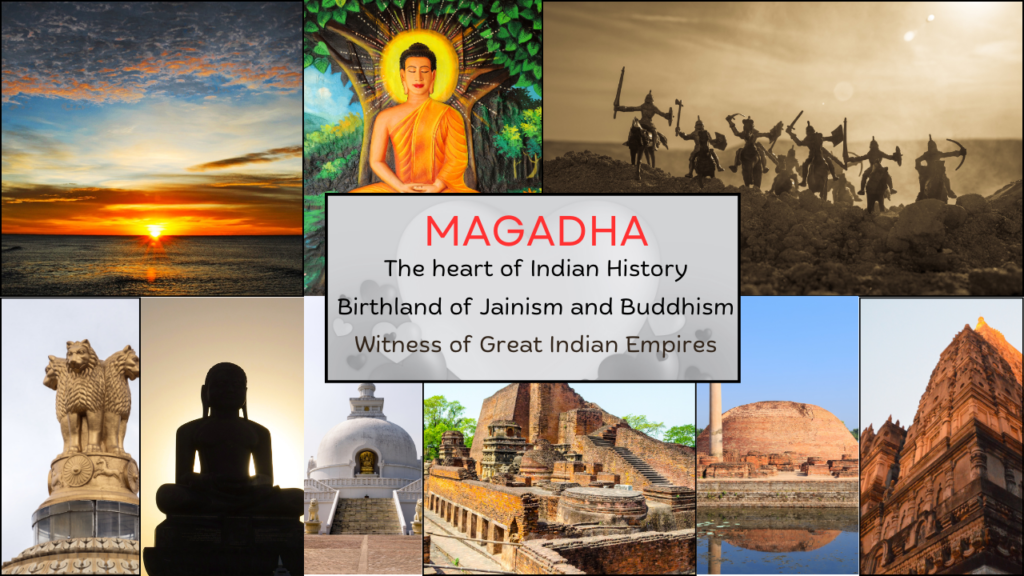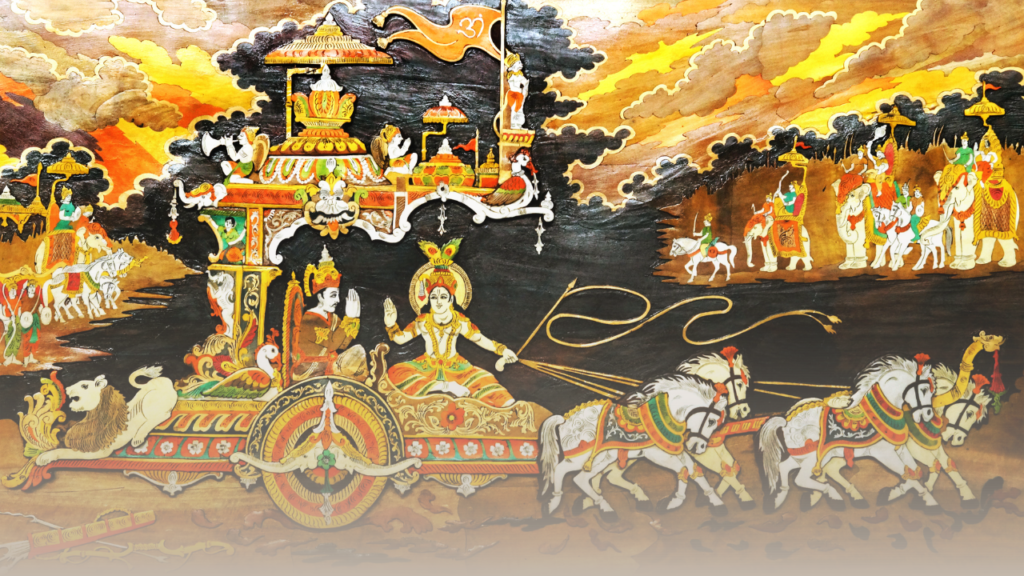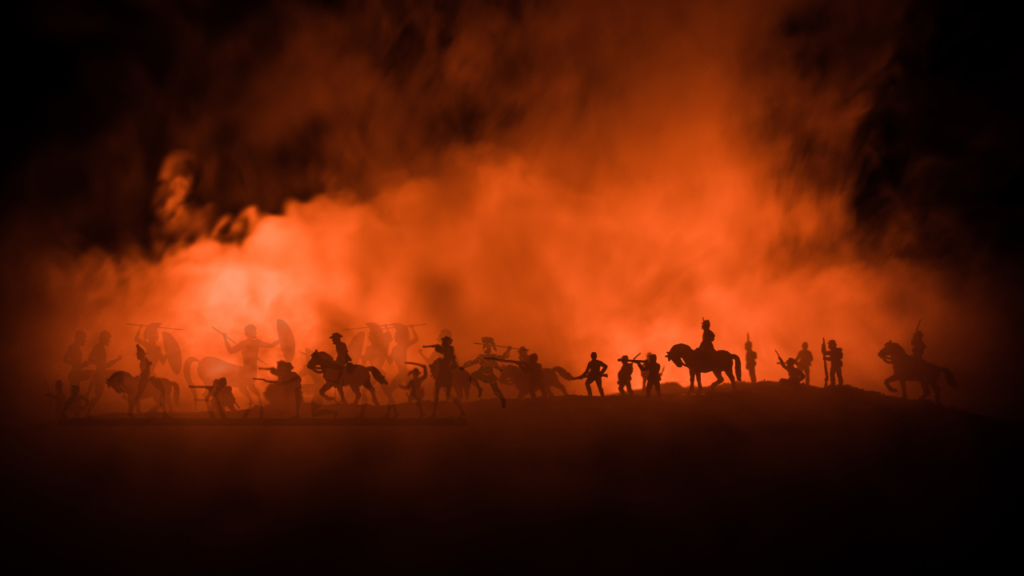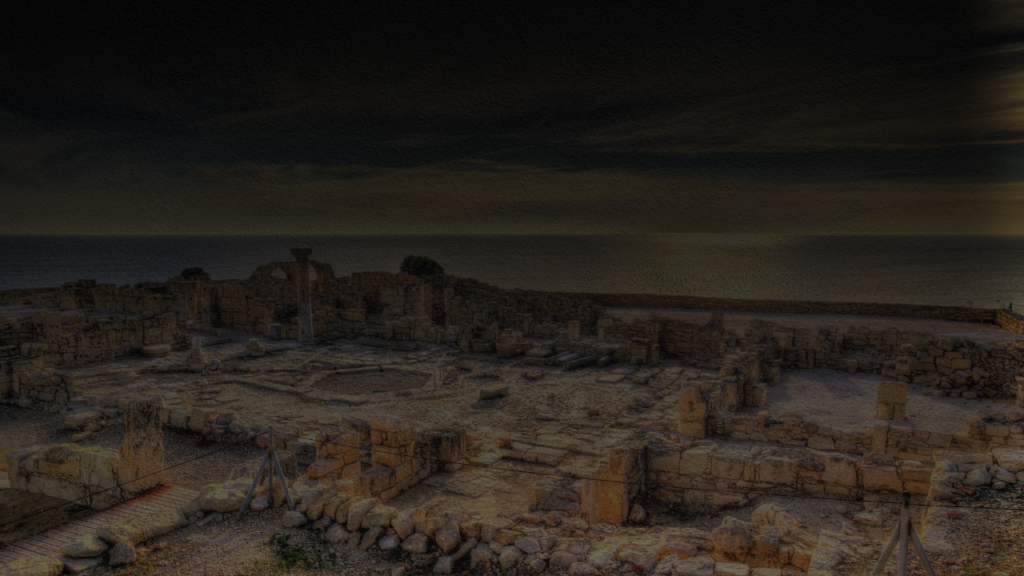
Magadha does it sound familiar?
Magadha is a historically significant region in India and has been the seat of power for many renowned dynasties. It played a very important role in shaping Indian history, serving as the birthplace of Jainism and Buddhism. Famous rulers like Chandragupta Maurya and Ashoka hailed from here. Today, Magadha is part of the west-central Bihar state, continuing its legacy as a center of cultural heritage and historical importance. Here I have tried to track the history of this very important place from the time of Ramayana to the present.
Let’s embark on the journey of Magadha…

Magadha’s roots were found in the Atharvaveda, but at that time it was not the place liked by people.
Ramayana knows of the Magadha, only as a place inhabited by opulent(Samruddhajanasevith – rich peoples) and fertile with rich fields of corn.
Magadha at the time of Mahabharata

| Ruling Dynasty | Brihadratha – Ruled for 100 years |
| First King to ruled Magadha | Brihadratha Son of Vasu (king of Chedi kingdom) |
| Capital | Girivraj |
Some details
In the time of Mahabharata Magadha was ruled by Jarasandha son of Brihadratha. At that time it was a strong country and controlled the entire eastern part. Jarasandha was killed by Pandava Bheem in wrestling match. After that Sahadeva, son of Jarasandha succeeded to the throne and later died in the Kurukshetra War, fighting from the side of the Pandavas.
After the Kurukshetra War, the power of Magadha seemed to have diminished but it still continued to be an important kingdom and was counted among the 16 Mahajanpadas. According to the Vayu Purana, Jarasandha’s descendants ruled Magadha for 1000 years.
Recent findings
It’s quite fascinating! The Pradyota dynasty once believed to rule Magadha after descendants of Jarasandha for 138 years, might not have ruled there after all! Recent findings suggest they might have ruled from Avanti, a neighboring region. This discovery reshapes our understanding of history. It’s possible that during that time, Magadha was actually under the Haryanka dynasty, led by King Bimbisara or his father, who took over around 544 BCE after the Brihadratha dynasty’s reign. History has a way of surprising us with unexpected twists and revisions.
The era of Magadha from Bimbisara to Dhana Nanda is like a gripping tale of power
As I mentioned earlier, Magadha was in the control of the Haryanka dynasty after the decline of the Brihadratha dynasty.
Haryanka Dynasty
| Notable kings | King Bimbisara and his son Ajatashatru |
| Capital | Rajagriha (Girivraj) |
During the time of Bimbisara, In this time Gautam Buddha came to Magadha and attained enlightenment at Bodhgaya.
In the time of Ajatshatru, Magadha covered almost all of modern Bihar, Chandigarh , Haryana, Uttarakhand, Himachal Pradesh, Delhi, Uttar Pradesh, One fourth Madhya Pradesh, the tip of Chhattisgarh, Jharkhand, and West Bengal.
The birth of the Famous Magadha capital Pataliputra
To strengthen the defenses of Magadha he built a fort near the banks of the Ganges river and named it Pataliputra. His Successor Udayin shifted the capital from Rajgriha to Pataliputra.
What after Harnyka???
After the Haryana Dynasty, the Shishunaga dynasty took over around 413 BCE. Shishunaga, who had been a minister under the Haryankas, founded this new ruling house. His decision to make Vaishali a secondary capital of Magadha brought a fresh dynamic to the region’s politics. However, the rise of the powerful Nanda dynasty around 345 BCE quickly overshadowed the legacy of the Shishunagas, ushering in another significant period in Magadha’s history.
Contribution of the Nanda Dynasty
The founder of the Nanda dynasty was Mahapadma Nanda. He reconquered all the lands of Mahadha, which was lost by successors of Ajatashatru. At that time Magadha was very powerful state. Magadha’s army consisted of 20,000 cavalry, 200,000 infantry, 2000 chariots, and 3000 elephants.
Magadha was at its greatest extent at the time of Dhana Nanda, extended from Bengal in the east, to Punjab in the West and as far south as the Vindhya Range.
The rise of the mighty Maurya Empire- Stepping inside India’s glorious past.
| Notable Kings | Chandragupta, Bimbisara, Ashoka |
| Capital | Pataliputra |
As we all know , Nanda dynasty was overthrown by great Chandragupta Maurya around 322 BCE with the help of his guru Chankya.
Accomplishments
Chandragupta built strong and powerful army and started to conquer kingdoms in north and south. By the time he completed conquest, Magadha empire extended over most of the Indian subcontinent. This was the first time in the history of India that so many kingdoms came under the same royal umbrella.
At the time of Chandragupta Mauryan Empire extended from Bangladesh to Afghanistan, and incorporate most of the Indian subcontinent except south most region(Now Tamil Nadu, Kerala and Nearby) and Kalinga(now Odisha).
Chandragupta built such a vast empire ever known in history and maintained it with very professional administrative skills with the help of his Guru Chankya.
Continuing father’s legacy .. Bindusara and his achievements
Bindusara inherited his father’s throne. He didn’t rest and continued his father’s conquest and annexed 16 states between Bay of Bengal and Arabian sea except Kaling.
The conquest of Ashoka… Reaching the highest glorious time in Indian history

After Bindusara, his son Ashoka came to the throne. In world history, many kingdoms were made by swords but the kingdom of Ahoka was built by peace. Ashoka conquered the Kalinga, but in that bloody conquest, he changed thoroughly and became the lay discipline of Buddhism. He played very important role in spreading Buddhism throughout the enlarged Maurya empire and into neighboring lands such as Central Asia, beyond the Mauryas’ northwest border, China, and to the island of Sri Lanka south of India.
The progress toward peak

Mauryan time was the most peaceful time of the Magadhan history. There wasn’t any war between kingdoms, so people were more concentrated on trade and commerce. At this time first time mining of Iron started and using iron many new tools and weapons were developed. Art and architecture were at their peak, Ashokan pillars are great examples of that. The Maurya Dynasty gave India three consecutive greatest Kings ever known in history, they all completed remarkable tasks and made India Shine forever.
Post Mauryan time in Magadha.. Falling from peak
After Ashoka, there were not any significant ruler and Magadha lost his glory and started to shrink. Pushyamitra Shunga revolted against the last Maurya king and founded Shunga dynasty.
By the time when Pushyamitra sized throne, Magadha left only a fraction of its original size, reduced only to three states Pataliputra, Ayodhya, Vidisha, and some parts of Punjab.
Attacks from Satvahana

The Shunga Dynasty also faced an internal revolt and was replaced by the Kanva dynasty. At the same time, the Satvahana Dynasty rose in the south. They started to attack Magadha. The Second king of the Kanva dynasty was Bhumimitra, who fought many wars against Satavahanas.
After that Satvahana got busy with their internal problems and stopped attacking Magadha. Kanva rulers after Bhumimitra, ruled peacefully. Around 30 BCE Satavahana again attacked Magadha, this time they defeated the last Kanva king Susharman, and annexed their kingdom. Even though Satavahana conquered Magadha, it is not possible to assign them in the history of the Magadha, because the Satavahana was originally the ruling dynasty of Deccan.
Here arose two important questions.
Did Satvahana rule from Pataliputra for some time?
Did the political center of gravity shift to Paithan, leaving northern India to its fate at the hands of Sakas and Khusanas?
These questions cannot be satisfactorily answered.
Golden time of Magadha… Rising again…
Magadha rose again on the Indian map with the rise of the Guptas around 240 CE.
First king of Gupta dynasty – Shri Gupta
Their original home was believed to be near Bengal. Some believe that they first concentrated in the region of Magadha and from there they extended their sway to Bengal. Whereas, others believes that from their original homeland in Bengal, they extended their empire to Magadha.
Chandragupta –1 – started conquest to unify India
Gupta Empire came to be known by the grandson of Sri Gupta, Chandragupta -1. He started to expand his kingdom with conquests and matrimonial alliances. His empire included Prayaga(Modern Allahabad) and Saketa (Ayodhya), he also defeated the Magha kings of Kaushambi and Kosala and annexed them into Gupta empire.
Samudragupta – Mission continues
With solid roots in the Gupta Empire, Chandragupta-1 passed the throne to his son Samudragupta. Samudragupta didn’t rest after getting a large empire, he proved himself a great conqueror and expanded the Gupta empire from the Himalayas in the north to the river Nalanda in the south and from the Brahmaputra in the east to the Yamuna River in the west. His greatest achievement was the political unification of most of India into a formidable Power. Although he conquered many provinces he still maintained the peace and amity among his people.
He started the golden age of India

During his rule, art and culture flourished as well thus it is believed that he put roots in the golden age of India. After 40 years of peaceful ruling throne was passed to his son Chandragupta-2.
Chandragupta –2 – Vikramaditya
Chandragupta-2 also continued to expand the kingdom with conquests and matrimonial alliances. After defeating Saka rulers he annexed Gujarat and Saurashtra. He also exercise indirect rule over the Vaktaka Kingdom. After winning Malwa, he made Ujjain his second capital. But Pataliputra continued to be a primary center for power. Chandragupta-II controlled a vast empire from the mouth of the Ganges to the mouth of the Indus and noe what is north Pakistan down to the mouth of Narmada.
The start of the Indian Calendar
Traditionally, it’s believed that Vikramaditya started the Vikrama Samvat calendar in 57 BCE after defeating the Shakas. However, the term “Vikrama Samvat” wasn’t used until the ninth century CE
Towards the end of the Golden time
Kumaragupta – the last notable king of the Gupta empire
Kumaragupta – I succeeded his father Chandragupta-II. He didn’t expand the kingdom further but kept the vast empire intact. After that, there were no significant Gupta rulers, and the Empire started to decline.
The decline of Guptas .. The end of the golden age
- Around 480 CE, the Alcon Huns, led by Toramana and Mihirakula, broke through the Gupta Empire’s defenses in the Northwest. By 500 CE, much of the empire had been overrun by the Huns.
- Additionally, the Gupta authority was weakened by the rise of feudatories
Power Struggle

Following the decline of the Gupta Empire, the Later Gupta dynasty became prominent, replacing the imperial Guptas. While there’s no solid evidence connecting the two dynasties, it’s believed that the Later Guptas were a distinct dynasty who might have adopted the Gupta name to legitimize their claim as successors to the imperial legacy
Initially, The later guptas and Maukhariys related through marriage, but later they developed a rivalry. Afterward, Pushybhuti king Harshavardhana restored the Later Gupta in Magadha and they ruled as Harsha’s vassals.
After Harshavardhana’s death, a power struggle ensued between the kings of Kannauj and Magadha, with Kannauj ultimately regaining dominance. This marked the end of Magadha’s era of power. As the Later Gupta dynasty declined, Magadha’s history lost its vibrancy. It became less influential and was overshadowed by other powers. Our understanding of Magadha’s political journey becomes uncertain from this point onward, Magadha was not a hunter but prey to others’ ambitions.
Rise of the Pala Dynasty – the last Buddhist dynasty of Magadha
Founder of the dynasty – Gopala
Struggle of Magadha..
Magadha faced constant attacks from Kannauj and Lalitaditya of Kashmir, leaving it in chaos and insecurity. However, Gopala emerged as a hopeful leader amidst the turmoil, founding the Pala dynasty around 750 CE. His conquest of Magadha led to its inclusion in the powerful Pala empire, where it thrived for centuries.
Successor – Dharampala and son Devpala
Foundation of Vikramdhila University

Dharmapala succeeded Gopala and ruled over present-day Bengal and Bihar. Pala rulers were the followers of the Buddhism. Dharmapala revived the Nalanda University and founded the Vikramshila University which later evolved into a great learning center of Buddhism. He ruled for 40 years and was then succeeded by his son Devpala.
Devpala was the most powerful ruler of the Pala Dynasty. He expanded his empire. His empire extended up to Vindhyas, the Himalayas, and the two oceans (Presumably the Arabian Sea and the Bay of Bengal). It also claims that Devpala exterminated the Utkalas(Rulers of the current state of Odisha), Conquered Pragjyotish, Shattered the pride of Hunas, and humbled the Loads of Gurjara and Dravidas. These claims are exaggerated but cannot be dismissed entirely. Devpala was a follower of Buddhism and he is said to have built many temples and monasteries in Magadha. Devpala ruled for 40 years.
Decline and the name Magadha buried in the pages of history forever
The empire was considerably weakened by the 11th century with many areas engulfed in rebellion. The Hindu Sena dynasty dethroned the Pala Empire in 12th century. The Palas were the last major Buddhist imperial power, their period is considered one of the golden eras of the Bengali dynasty.
After Palas Magadha lost its ancient glorious name in the page of history, Now we follow the history of Bihar to connect the dots for what happened in Magadha.
Darkest Time in Magadha

The name Magadha is now buried under the pages of history…
In the 6th-7th century, Pataliputra was devastated by the migration of the Son river, the Chinese pilgrim Xuanzang recorded that in 637, the city had few inhabitants. It regained its glory during the Pala empire but it only once made the capital of the Pala dynasty during the region of Devpala. After that, it declined and was deserted by the 7th century. The city was re-founded as Patna by an Afghan ruler in 1541.
Destruction by the Afghan invaders
Right from the 11th century, Magadha(Bihar) came to be attacked by Islamic invaders from the Middle East. It was attacked by Muhammad of Ghor several times. He destroyed a lot of Buddhist monasteries and killed many innocent people. The final blow was struck by Muhammad Bin Bakhtiar Khilji in 1203. He attacked Bihar and burnt Nalanda University and Vikramshila University, he burnt a lot of books which were about the glorious past of Great Magadha(Bihar).
How the Bihar got its name
When Bakhtiyar khilji came to Magadha for searching booty. They tried to capture so so-called fortress of Bihar(which was in reality a Buddhist monastery, possibly the famous monastery of Odantapuri). It was only after storming the massive structure of the vihara and killing the ‘shaven soldiers’ that invaders discovered that they were not soldiers but monks living in a monastery. It is this fortuitous event that the Indian State of Bihar (Vihara) owes its name, as Turkish conquers started referring to the whole country as Bihar. After the conquest of Khilji the darkest time of Bihar started. No one or any writer has ever written a detailed record of it.
Some efforts are done by Sher Shah Suri
The medieval history of Bihar is commemorated by the foreign invasion and dynasty that ruined the glory of Bihar. It saw some glory for about six years under the rule of Sher Shah Suri. He made some economic reforms such as introduction of the Rupee and Custom duties are still used by the current Indian Government. He tries to restore the glory of Patna(Pataliputra) and make it his headquarter.
Mughal Rule to Modern Time
A little ray of light and again darkness
After that Bihar again saw some peaceful time under the rule of Akbar (from 1557 to 1576). He divided Bihar and Bengal each into its original twelve subahs (imperial top-level provinces; Bihar with capital at Patna). With the decline of the Mughals Bihar passed into the control of Nawabs of Bengal. This period saw Bihar’s exploitation at the hands of the rulers in the form of high taxes, but the Nawabs of Bengal also allowed trade to flourish in the region.
After the Battle of Buxar (1764), the East India Company established direct control over Bihar, Bengal, and Odisha. Due to the fertile soil, abundant water, and skilled labor, this region attracted colonial powers including the Dutch and the British in the 18th Century.
In 1912, Bihar and Orissa were carved out as a separate province from the Bengal Presidency. Later on, in 1935, certain portions of Bihar were reorganized into the separate province of Orissa. At Independence in 1947, the State of Bihar, with the same geographic boundary, formed a part of the Republic of India, until 1956. At that time, an area in the south-east, predominantly the district of Purulia, was separated and incorporated into West Bengal as part of the Linguistic Reorganization of Indian States. The state of Jharkhand was carved out of Bihar in the year 2000.
Conclusion
That was quite the journey from Magadha to Bihar, and from Pataliputra to Patna. Along the way, Magadha experienced both triumphs and tragedies. It produced some of India’s greatest rulers while also enduring its darkest moments. In its golden age, it gave rise to two very popular religions Buddhism and Jainism. It climbed at the highest peak and fell to the lowest creek. Its story holds some of the most significant chapters in Indian history, which is never to be forgotten.

